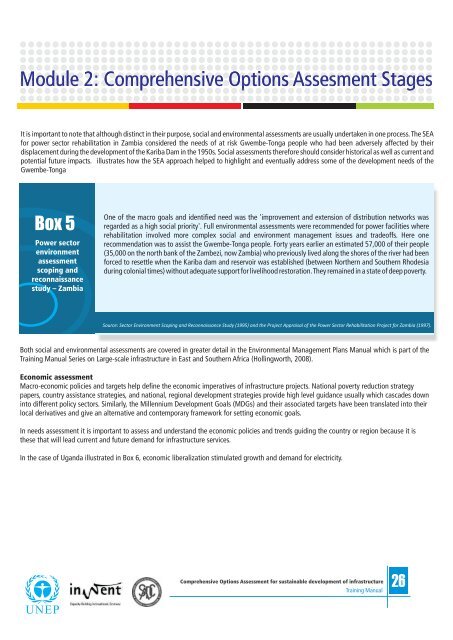Comprehensive Option Assesment - UNEP
Comprehensive Option Assesment - UNEP
Comprehensive Option Assesment - UNEP
Create successful ePaper yourself
Turn your PDF publications into a flip-book with our unique Google optimized e-Paper software.
Module 2: <strong>Comprehensive</strong> <strong>Option</strong>s <strong>Assesment</strong> Stages<br />
It is important to note that although distinct in their purpose, social and environmental assessments are usually undertaken in one process. The SEA<br />
for power sector rehabilitation in Zambia considered the needs of at risk Gwembe-Tonga people who had been adversely affected by their<br />
displacement during the development of the Kariba Dam in the 1950s. Social assessments therefore should consider historical as well as current and<br />
potential future impacts. illustrates how the SEA approach helped to highlight and eventually address some of the development needs of the<br />
Gwembe-Tonga<br />
Box 5<br />
Power sector<br />
environment<br />
assessment<br />
scoping and<br />
reconnaissance<br />
study – Zambia<br />
One of the macro goals and identified need was the 'improvement and extension of distribution networks was<br />
regarded as a high social priority'. Full environmental assessments were recommended for power facilities where<br />
rehabilitation involved more complex social and environment management issues and tradeoffs. Here one<br />
recommendation was to assist the Gwembe-Tonga people. Forty years earlier an estimated 57,000 of their people<br />
(35,000 on the north bank of the Zambezi, now Zambia) who previously lived along the shores of the river had been<br />
forced to resettle when the Kariba dam and reservoir was established (between Northern and Southern Rhodesia<br />
during colonial times) without adequate support for livelihood restoration. They remained in a state of deep poverty.<br />
Source: Sector Environment Scoping and Reconnaissance Study (1995) and the Project Appraisal of the Power Sector Rehabilitation Project for Zambia (1997).<br />
Both social and environmental assessments are covered in greater detail in the Environmental Management Plans Manual which is part of the<br />
Training Manual Series on Large-scale infrastructure in East and Southern Africa (Hollingworth, 2008).<br />
Economic assessment<br />
Macro-economic policies and targets help define the economic imperatives of infrastructure projects. National poverty reduction strategy<br />
papers, country assistance strategies, and national, regional development strategies provide high level guidance usually which cascades down<br />
into different policy sectors. Similarly, the Millennium Development Goals (MDGs) and their associated targets have been translated into their<br />
local derivatives and give an alternative and contemporary framework for setting economic goals.<br />
In needs assessment it is important to assess and understand the economic policies and trends guiding the country or region because it is<br />
these that will lead current and future demand for infrastructure services.<br />
In the case of Uganda illustrated in Box 6, economic liberalization stimulated growth and demand for electricity.<br />
<strong>Comprehensive</strong> <strong>Option</strong>s Assessment for sustainable development of infrastructure<br />
Training Manual<br />
26
















